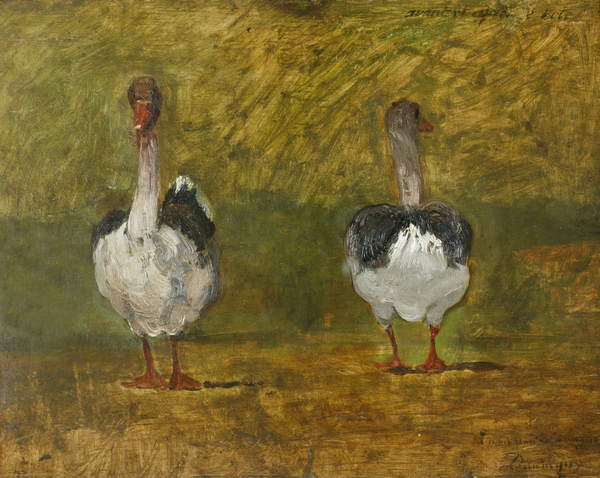Avant et Apres le Vote
Charles Francois Daubigny 1817 - 1878
Summary
Two geese, one walking toward the viewer, the other walking away, are depicted against a background of gestural, watered-down brushmarks in yellows, oranges and browns, which represent the varied colours of the landscape. The title of the work translates as Before and After the Vote. It could refer to the heavily rigged plebiscite of 22 and 23 December 1851, when 92% of the population supposedly voted in favour of ratifying Louis Napoléon's coup d'état of 2 December 1851. This humorous political sketch is addressed to Daubigny's friend and fellow artist, Hippolyte Lavoignat (1813-1896), who made many wood engravings after Daubigny's illustrations and was himself a follower of Daumier. Daubigny was closely associated with the group of painters who lived and worked in and around the village of Barbizon on the edge of the Forest of Fontainebleau, south east of Paris, in the mid-late 19th century, although he never lived there himself. He is best known for his naturalistic scenes of the River Oise and its tributaries, with which he made his reputation at the Paris Salon, and for coastal views. His preferred subject matter was gentle, domesticated countryside, devoid of human figures and peopled only by cows and ducks.
Display Label
Channel Crossings English and French Impressionism and Post-Impressionism from the collection of Manchester Art Gallery This display looks at the allure and excitement of French art for a generation of English and Scottish painters emerging from the claustrophobia of late Victorian painting. Breaking with the Classical rigours of the Academy and the Salon, the artists who came to be known as the Impressionists painted naturalistic scenes with loose and quickly applied brushwork to convey the effects of light and the natural colours of shadows which had previously been rendered with blacks and browns. They explored the French countryside where they learned how to paint directly en plein air closely studying the changing effects of the seasons. Making regular visits to or studying in Paris, English and Scottish artists were in turn enthralled by these painterly discoveries. The new method of painting they then applied to the English landscape, to still lifes, portraits and interiors. Painters of the New English Art Club like George Clausen, John Singer Sargent and Philip Wilson Steer combined the subject matter of late Victorian genre scenes with the new style. Works by these artists and others are here shown alongside a few choice examples of French Impressionism from the collection and by the fore-runners of Impressionism; Eugène-Louis Boudin, Charles Daubigny and Johan Jongkind. While the English artists went to France the French painters and their dealers, such as Paul Durand-Ruel, escaped the Franco-Prussian war of 1870-71 and went to London. Their paintings were seen in England and some were even bought by Manchester collectors. In the Edwardian era newer developments in French art inspired English and Scottish artists on their cross-Channel trips and via a series of influential London exhibitions. The high-keyed colour and bold lines of the Post-Impressionist paintings of Paul Gauguin and Vincent Van Gogh were now huge influences on the artists of the Camden Town Group such as Harold Gilman and Charles Ginner. Later still Matthew Smith was to take his inspiration directly from Henri Matisse under whom he studied in Paris.
Object Name
Avant et Apres le Vote
Creators Name
Dimensions
framed: 43.5cm x 51.6cm
object (object:(9 1/2 in)):
accession number
1995.38
Place of creation
France
Support
panel
Medium
oil paint
Legal
© Manchester Art Gallery

